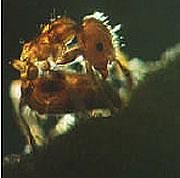 Peruvian ants kill off unwanted plants with a lethal injection.© Nature
Peruvian ants kill off unwanted plants with a lethal injection.© NatureResearchers have found an earthly cause for a phenomenon that Peruvian locals call 'devil's gardens' in the Amazonian rainforest. These gardens consist of just one type of tree (Duroia hirsuta). This is such an eerie and unusual sight in the otherwise diverse Amazon that locals presumed there to be a supernatural cause. But US researchers say it's ants, not the devil, that make this tree bloom.
The ants (Myrmelachista schumanni) live inside the trees' hollow stems, safe from predators and the environment. They kill all plants other than their host plant by injecting formic acid into the leaves. In this way, they help their host plant, and their own colony, to spread. Such gardens can hold more than 300 trees and millions of ants, and can be hundreds of years old.
“They create a single species stand of plants in one of the most diverse places on the planet.”
Deborah Gordon
Stanford University, California
"It's amazing that the ants exert so much control over their environment," says Deborah Gordon of Stanford University, California. "They create a single species stand of plants in one of the most diverse places on the planet."
Killer injections
Some previous studies have suggested that ants or the trees themselves were killing the surrounding plants, but no one could explain how. Now Megan Frederickson of Stanford University and her colleagues, including Gordon, report in Nature1 that the ants do it through injecting a natural poison.
The researchers planted saplings of a common Amazonian cedar tree (Cedrela odorata) inside an ant-infested forest. When they kept the ants away, the cedar trees thrived. But when ants had access to the young trees, the cedars all shed leaves after about five days.
It seems that the ants bite a hole in the leaves and deliver a droplet of formic acid from their abdomens. The plant's vascular system then spreads this acid throughout the entire plant. Within hours of the attack, brownish areas appear along the veins of its leaves.
"In hindsight it's obvious," says Susanne Renner of the University of Munich, Germany. She studied devil's gardens in Ecuador seven years ago, but was unable to explain how the ants killed the plants.
So happy together
Formic acid is very common among ants: about one-quarter of the 15,000 ant species produce it, says Jack Longino, an ant researcher at Evergreen State College in Olympia, Washington. Many ants use it to defend themselves against animal or insect attack. But this is the first time that ants have been seen using it as a herbicide, he adds.
ADVERTISEMENT
The devil's garden relationship joins a growing list of partnerships between plants and ants. Some plants have evolved to grow food for resident ants, which protect their host in return. Other ants physically cut away at neighbouring vegetation to help their host plants spread.
But how can an ant tell whether a plant is the same species as its host or different? That's the next mystery Frederickson wants to solve. She also wants to see whether the ants can kill mature trees as well as saplings, and find out how widespread devil's gardens are in the Amazon.
Stanford University, California
